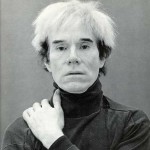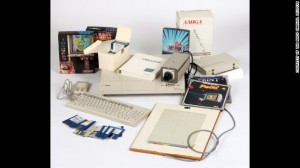
For those who don’t see much overlap between science and art, just read this. It will surprise you. Andy Warhol, best known for pop art paintings of Campbell’s Soup and Marilyn Monroe, started working with a new personal computer, the Amiga, to create art only a couple years before his death in 1987. Now, this may surprise you young’uns, but back in 1985 computers were very primitive. Heck, the Internet wasn’t even invented yet, so you wouldn’t be able to read this blog for another decade!
So here’s the predicament: Art historians and museum workers can restore statues, x-ray paintings, and more—but today, in our digital age, how do we repair paintings made on computers with outdated technology? No one really had answers, so Warhol’s digital artwork, contained on ancient floppy disks kept in the Andy Warhol Museum in Pittsburgh, Pennsylvania, was thought to be lost forever. That didn’t stop NYC-based artist Cory Arcangel, though.

After several years of computer work, Arcangel, along with the Computer Club of the Frank-Ratchye STUDIO for Creative Inquiry, found files on Warhol’s floppy disks and hard drives with names like “campbells.pic” and “marilyn1.pic.”
However, the programs Warhol used to create these pictures was very outdated. What to do? There’s only one thing they could do to open these files: reverse-engineer the software, a very complex process that this particular blogger doesn’t understand. Finally, they were able to open the files, which show an artist in progress. Warhol’s computer work re-created his Campbell’s Soup cans, showed the creation of Venus, and even a music video featuring Debbie Harry, called “You Are The One.”

“In the images, we see a mature artist who had spent about 50 years developing a specific hand-to-eye coordination now suddenly grappling with the bizarre new sensation of a mouse in his palm held several inches from the screen,” said Matt Wrbican, the archivist.
More than anything, Warhol’s never-before seen computer art reveal his willingness to experiment and cement his status as a cutting-edge and groundbreaking artist. You can read more here. Warhol’s Self-Portrait is featured in the Art Docent Program first-grade lesson, Self-Portraits, and his Campbell Soup is in the sixth-grade lesson, Later 20th Century.

Here’s a video of Warhol working on the computer:
FOLLOW-UP: This particular blogger may not understand what reverse engineering is exactly, but he does recommend watching Halt and Catch Fire, AMC’s new TV show about the ’80s computer industry, in which the two main characters reverse engineer an IBM computer. Apparently it’s really hard to do.







